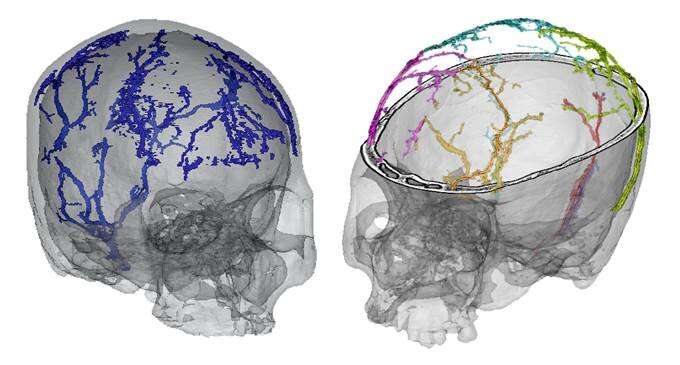A study analyzes the growth and development of the diploic veins in modern humans
by Science X staff
A study coordinated by Emiliano Bruner, a paleoneurologist at the Centro Nacional de Investigación sobre la Evolución Humana (CENIEH), on the growth of the diploic veins throughout human development (between one year of age and adulthood) shows that, while these vessels develop constantly, it is only in the adult phase that a substantial increase is detected.
To carry out this study, published in the American Journal of Physical Anthropology, a total of 71 crania were examined using micro-computed tomography, looking at the lumen size, length and volume of the vessels at different ages and in the frontal, parietal and occipital bones, as a function of the size of the cranium and the thickness of the bone.
"The factor that probably constrains the development of these vessels is the thickness of the spongy layer of the bone, which increases noticeably in size and variability during the final stages of cranial growth," explains Bruner.
The diploic veins develop within the bones of the cranial vault, leaving channels which can be identified in the cranium thanks to biomedical imaging techniques, and they can be identified in collections of crania, as well as in archaeological populations, and even in fossils.
They form a vascular system which communicates the blood flow within the cranial cavity with the vascular system outside the cranium and, in addition to oxygenating the cranial tissues, they may be associated to regulating pressure and temperature in the brain.
Recent evolution
Earlier studies have shown that this vascular network is particularly well-developed only in our own species, Homo sapiens, if we compare it with other primates or extinct hominins. "This suggests that this vascular system evolved recently, possibly as a result of a functional adaptation, which could for instance be thermoregulation of the cranial cavity," says Bruner.
More information: Gizéh Rangel‐de Lázaro et al. Ontogenetic changes of diploic channels in modern humans, American Journal of Physical Anthropology (2020). DOI: 10.1002/ajpa.24085
Journal information: American Journal of Physical Anthropology
Provided by CENIEH